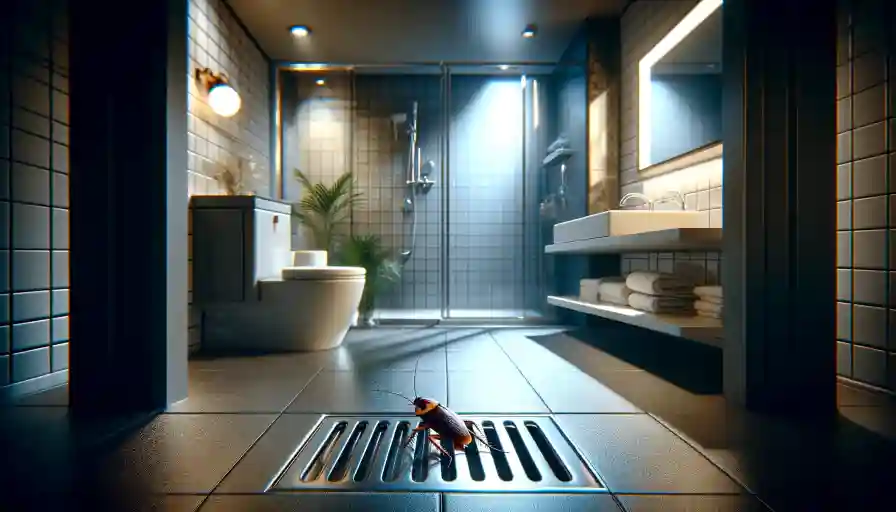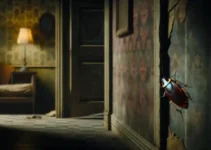Where do roaches come from in the bathroom? It is easy for cockroaches to infest bathrooms, just like in kitchens. But it’s odd how these ferocious pests find the bathrooms, especially if the doors are not directly outside the house.
Normally, cockroaches enter bathrooms crawling their way up through drains and openings in baseboards. They also get in through broken pipes and cracks in walls and ceilings. Other times, cockroaches gain access through different rooms in the building and move to the bathrooms lured in by the water and humidity.
Bleach, insecticide, vinegar, or baking soda in your drain will get rid of roaches but won’t immediately solve your roach problem. Pouring boiling water down the drain would work even better. However, professional pest removal services work better.
Why am I getting cockroaches in my bathroom?
Cockroaches consider bathrooms their ideal breeding ground, even when clean it thoroughly. This is due to the fact that your bathroom provides the roaches with: food (cockroaches can eat soap and human cells) and water (from your bathroom sink, drains, and water heater).
Roaches are naturally attracted to your bathrooms—it has all roaches needed to survive, including:
Water. Irrespective of the water source, whether from the toilet, sink, or bathrooms, cockroaches.
Good hiding spaces. Cockroaches know that they are always in danger. They tend to hide when they notice any movement. Bathrooms give them the perfect places to hide, like cabinets, behind the toilet bowl, trash can, shelves, and under the bathtub. No matter how small a hole is, roaches can squeeze their way in.
Heat. Cockroaches’ populations flourish in warm environments. Your shower provides steam and a warm climate for the roaches. If other parts of your home are cold, the bathroom will be the best place for cockroaches to live.
Food. Bathrooms supply substitute food sources like toothpaste, soap, toilet paper, and skin Products with chocolate, cream, or mud for the roaches.
Darkness. Cockroaches love a solitary place where they can be untroubled. Most areas in the house are often flooded with lights, but the bathroom tends to be dark. They prefer a place with fewer human interactions.
Where do roaches come from in the bathroom?

You’ve just seen that cockroaches find bathrooms as their haven, so they’ll easily nest in them. Now, where do roaches come in from the bathroom?
Cockroaches gain access to the bathrooms in several ways that homeowners may not know. They may gain access directly. Also, they may create pathways in your home or workspace.
a. Broken pipe
If you’re wondering “I found a cockroach in my shower” your drains and pipes are typical places cockroaches use to enter your bathroom. If they are broken, pipes can give easy entry to cockroaches. You might think a leak in your sewage pipe is too minor, but that may be the primary opportunity roaches look for to come in and start an infestation.
As soon as the roaches are inside your home, the pipes give them easy access in and out. The cockroaches will begin trailing every area of your house, exploiting other leaking pipes to gain extended access. Cockroaches will come through the drain since most plumbing leads to the bathroom.
Broken pipes in a building could be more of a problem than you think. Once there’s a roach infestation in one apartment, it can lead to an infestation in the surrounding areas.
If neighbors don’t take care of their infestation, roaches can spread their population into your bathroom. The moment your neighbor runs out of food sources, cockroaches will migrate to nest in your bathroom.
Neighbors fumigating their house may also make cockroaches move to your home. Pipes will help them in transitioning to new safe places.
b. Cracks or holes in walls
It’s typical for openings and cracks to begin to develop on the outside of a building once it ages. Tiny crevices may develop on the building’s trimming, foundation skirt, paneling, or corners. If they expand, it can lead to leakage and damage to the structure. But a cockroach only requires a tiny opening to access your bathroom. For instance, new research shows the American cockroach (Periplaneta americana, aka “the big ones”) can squeeze through a crack the height of two stacked pennies in about one second.
c. Tiles and baseboards
Always inspect the tiles and baseboards within your home. Roaches can squeeze themselves through tiny holes in the foundation. Tiling makes it easy for the cockroaches because a little crack won’t ruin the whole square but can provide an opening.
When wooden baseboards are exposed to water and steam, they’re likely to break or deform. If baseboards are correctly fixed, they should last for a reasonable amount of time. However, frequent exposure to showers will distort the wooden baseboards in due course, despite using a water-resistant coating.
d. Door gaps
Yes, a cockroach might gain access to a building through a different place. But it could move to the bathroom as soon as it is inside. You could keep your kitchen adequately cleaned, but when the food source is taken away from roaches, they will find the bathroom attractive.
To gain access, a cockroach will make openings under the doors. Cracks below the door might help the roach easily find its way to the bathroom.
Roaches coming through the toilet
We’ve established that cockroaches gain access to the bathroom through pipes. But can roaches pass through the toilet? Can roaches crawl up from the sewage system into your bathroom?
Why roaches won’t enter your bathroom
Are roaches coming through bathroom vent? Most toilets these days have a water trap. The water trap is in the form of a pipe beneath your toilet. The purpose of the water trap is to prevent gasses from coming up from the sewer into the tank.
The water trap is filled with water. This helps create an enclosure around the gasses to prevent them from rising. Suppose a cockroach scales through the pipe. It would have to pass through a lot of water to access the toilet. There’s a high chance that a roach will drown before it gets to the toilet.
What if you find a roach in your toilet?
There may be 2 reasons for this:
- Your toilet doesn’t have a water trap
- Your toilet is clogged
In both cases, a foul odor will always rise from your toilet into your bathroom. The smell rises directly from the sewer system if you lack a water trap.
If you have a clogged toilet, roaches will easily circumvent the water trap. The odor is dangerous, so you must get rid of it.
Dead roaches in your bathroom?
If you discover a dead cockroach floating in your toilet bowl, there’s a chance it already has been in your bathroom. It was probably trying to get water from the toilet or to hide when it fell inside. The roach may have tried and failed to escape and then ended up drowning, depending on the texture and material of your toilet bowl.
Cockroaches can survive without oxygen for several minutes. So, it is tougher for them to drown though. If you just used the toilet and discovered a fresh roach body, the roach may have ingested poison and died while trying to drink.
Roaches from sewers
Sewer systems house a lot of pests, and bathrooms are linked to the sewer. This may make you think that a cockroach infestation in your bathroom means you have a damaged sewage system. There’s a high chance that:
- They came through broken pipes.
- Discovered an opening in your drain, which is left open beneath your building foundation.
Are roaches only in your bathroom?
If cockroaches are only found in your bathroom, there’s a high chance that your infestation is not contained in that area.
Cockroaches are often seen in the bathrooms because they’re easily trapped there. If a cockroach gets into a bathtub, for instance, it may not be able to get out of it. The slippery surface will make its chances of getting out very slim.
One cockroach in bathroom, should you be worried?
If you find 1 or 2 roaches, you should take it seriously. A single cockroach points to the presence of more cockroaches.
Your bathroom isn’t the only place cockroaches are attracted to in your home, so inspect surrounding areas to help contain the infestation.
With that said, one roach doesn’t necessarily mean you have a full-blown infestation. The key is to act quickly. There’s still a chance to exterminate them before it becomes a large-scale problem.
However, seeing one cockroach doesn’t mean you’re dealing with a massive infestation. The solution is to act immediately while you have a chance to get rid of them before the infestation becomes full-blown.
Roaches coming out of bathroom drain
It’s annoying to find a cockroach crawling out from the drain. It’s terrifying when it crawls out of the shower or bathtub drains while having your bath. Solving these cases is difficult because:
- It’s challenging to clean drains
- It’s tougher to get to the inner pipes
So can we exterminate cockroaches permanently? How do I keep roaches out of my bathroom? Follow these steps to remove roaches from your drain:
a. Diluted bleach
The corroding property of bleach may kill the cockroaches but will destroy your pipes. The bleach solution will consume metal, plastic, and other materials, which could end up leaving your drains with cracks or fissures, bringing in even more cockroaches. That’s if your pipes don’t get completely destroyed.
Therefore, it would be wise not to use bleach to remove cockroaches from your drain. If nothing else is available and you’re bent on getting rid of the roaches, ensure you dilute the bleach with water. It won’t be as effective as just bleach alone, but it will cause minor damage to your pipes.
b. Insecticide
Insecticides can get rid of cockroaches. But most brands are made to be sprayed directly on the pests or to fumigate your home. Pouring the insecticide down the drain may not yield the desired results.
Pouring an entire can down a drain will not only harm cockroaches but will also cause harm to other organic material close to it. It can leach into nearby water sources, the ground, and your sewage system.
Insecticides can remain on the soil for nearly 3 years. In some regions, dumping insecticides down the drain is illegal.
c. Vinegar and baking soda
Vinegar and baking soda are recognized as home remedies for blocked pipes and a way to eliminate cockroaches. A foaming reaction will be formed when you mix baking soda and vinegar. The reaction unclogs the pipes and kills roaches.
Vinegar isn’t as powerful as bleach. Note, however, that the vinegar and baking soda reaction may create excess pressure that could break the pipes. Note that vinegar is not effective against viruses in roach droppings.
d. Hot water
Try using boiling water if cockroaches try to make their way up your bathroom drain. Hot water won’t damage your pipes like bleach or insecticides; it won’t leach into the ground.
Just like bleach, water at boiling point will eliminate roaches when it comes in contact.
However, there are a few cautions if you want to use this option. Hot water can only be effective if it’s boiling. Especially during the cold season, if it is poured down a drain, it may get cold quickly. Water may not be hot again when it gets to the roaches at the bottom of the drain.
Roaches in bathroom at night
Roaches are nocturnal and prefer to lurk around in dark places or operate mostly at night. Have you seen baby roaches in bathroom at night? Below are conditions attracting roaches to your bathroom are night:
a. Darkness
Due to the few windows in the bathroom, the bathroom seems to be the darkest place in the house. The glasses are even fogged to reduce their transparency, making it hard for light to penetrate through.
b. Humid
Your bathroom will be left steamy if you shower before you go to sleep. This is a paradise for cockroaches because they love moist environments. The bathroom windows are mostly shut at night, making the bathroom maintain steam longer than during the day.
c. Quiet
Cockroaches are very alert. They know how to flee from danger. Since they can only sense danger through sounds, they prefer the quietness of your bathroom at night.
Roaches in shower
Roaches enjoy the water sources and may come up to the drain because of broken pipes. They’ll feast on any hair in the drain since it is an organic material rich in protein. Leaving your hair in the drain may encourage the roaches to find your shower. Your hair contains lipids and sebum, which can sustain cockroaches for some time.
Where do cockroaches hide in bathrooms? There’s a lot of water in your bathroom that will make cockroaches flourish, as well as places in your bathroom that provide the cover and hideouts, including your bathroom sink, toilets, and tubs. Your sink is a good hiding place for cockroaches, which provides sources of water. Roaches also like to hide in the drains, pipes, and wall gaps around pipes in your bathroom.
How to prevent roaches from entering bathrooms
Coming across cockroaches in your bathroom is sometimes inevitable if you live in a warm area. But you can lower their chances of getting in with the following steps:
1. Clean your bathroom
Cockroaches will flourish in a dirty bathroom. They’ll enter moist corners, mildew, and skin cells.
That being said, a clean bathroom isn’t sufficient to prevent the roaches from getting in. Ensure to take out and safely keep away items that attract cockroaches. Items like:
- Soap bars. Soap bars have high oil content, so cockroaches love to consume them. Some natural varieties of soap may also contain animal fat. Put your soap bars in a sealed can. You may also start using liquid soap.
- Toilet paper. Toilet paper should also be stored in a safe container. Usually, it is kept in the pack it came with until it’s needed for use. Cockroaches love paper, especially toilet paper. They don’t only use it for food, but they can transmit bacteria on it.
- Hairs. Roaches love to eat hair. Make sure you take out decomposing hair from your drains.
- Trash. Seal trash cans with their lid to prevent roaches from getting into them. Also, remove the trash bin from a dark corner.
2. Add water traps to sinks
Toilets these days need to have water traps. Make sure you fix them in other drains too. Water traps will help keep cockroaches away—they also help to prevent clogged drains.
3. Fix pipes
When fixing broken pipes, ensure that it’s a permanent fix. Temporal repairs will break down during cold months, which is the time when cockroaches mostly find a warm place to stay.
You can repair your pipes by yourself or with professional assistance. Aside from broken pipes, openings in the plumbing can pose a significant problem. Seal the openings between pipes and the surrounding areas. Close off holes between piping and walls. Build false cupboards or false cabinet backings to prevent cockroaches from getting in through the holes.
4. Repair cracks and holes
Other than broken pipes, walls and floors should be maintained. Small cracks in wooden walls, baseboards, and tiles should be caulked and patched up. Even the most minor cracks can lead roaches inside your bathroom. To keep your bathroom pest-free, regularly perform a maintenance check-up. At least once a year.
Aside from the leaky pipes, walls and floors should be taken care of. Little cracks in wooden walls and baseboards should be closed up.
Inspect corners where cockroaches like to stay. Also, look out for places where the wall intersects with the floors and ceilings.
5. Eliminate humid sources
Anything that makes your bathroom stay moist can draw cockroaches. To control humidity, consider the following:
- Adding a dehumidifier
- Installing a bathroom fan
This will make the bathroom less appealing to roaches and help prevent mold.
Bathroom mats are another regular source of moisture. If it is damp, ensure to take it from the bathroom floor and hang it to dry.
There are several water sources available to cockroaches in the bathroom, it may not be appealing to them, but it is a breeding environment for mold and bacteria. Try using anti-bacterial mats or mold and mildew-resistant mats.


